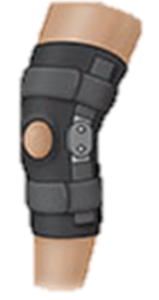Patella dislocation occurs when the kneecap dislocates outside of its normal position. This is usually around the outside of the knee. It can also partially dislocate, called a subluxation. The patella will sometimes go back to its original position, although this will be very painful.
Symptoms
- Pain will be felt immediately
- Swelling & obvious displacement of the kneecap
Anatomy
The patella lies in front of the knee joint. It glides up and down a groove called the patellofemoral groove at the front of the femur as the knee bends.
Dislocation occurs when the patella moves to the outside of this groove.
The patella is attached to the quadriceps via the quadriceps tendon and acts to increase the leverage of this muscle group when straightening the knee.
A patella dislocation is not the same as a dislocation of the knee joint itself which is a much more severe traumatic injury

Causes
It is usually a result of an acute blow or twisting action of the knee.
The factors which make a patella dislocation more likely are insufficient quadriceps strength, overpronation and an increased Q angle of the knee.
The vastus medialis oblique muscle (VMO) is the quad muscle on the inside of the thigh and is responsible for maintaining the stability of the patella. If the VMO muscle is not strong enough, the patella is much more susceptible to dislocation.
Overpronation of the feet is where the feet roll in or flatted too much when running. This causes the leg to turn inwards which leaves the patella susceptible to moving outwards as the quadriceps contract.
The Q-angle relates the angle of the lower leg to the knee, often termed knock-kneed. When straightening the leg the patella is forced to the outside potentially resulting in dislocation.

Treatment
In most cases the patella will relocate to the patellofemoral groove on straightening of the knee, however, this is usually extremely painful.
Apply RICE principles to the injured knee or rest, ice, compression, and elevation.
An athlete who has had one episode of patella dislocation is often susceptible to another. Patella stabilizing braces have been specifically designed to provide support for the kneecap.
When the acute symptoms settle down a full knee strengthening rehabilitation program is required to help avoid future recurrence.
Specifically exercises for the vastus medialis muscle on the inside of the quadriceps are important.

Contact Me
Let's chat!
Need more information? Send me an email or drop me a line. I don’t bite!
- Charlotte@rehabontheroad.co.uk
- 07971448719
